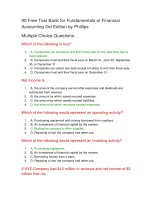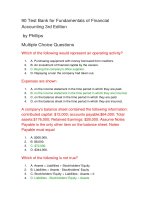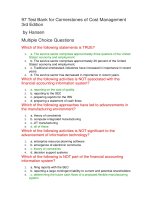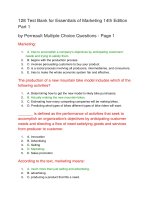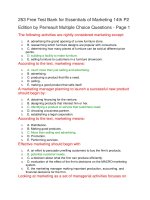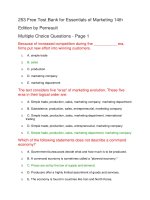80 test bank for essentials of strategic management 3rd edition hill
Bạn đang xem bản rút gọn của tài liệu. Xem và tải ngay bản đầy đủ của tài liệu tại đây (104.83 KB, 21 trang )
Test Bank for Essentials of Strategic Management 3rd
Edition Hill
Multiple Choice Questions
The capital that stockholders provide to a company is seen as
1.
a) play money.
2.
b) risk capital
3.
c) contractual capital.
4.
d) guaranteed capital.
5.
e) agency capital
Members of the board of directors are supposed to be agents for
1.
a) executive officers
2.
b) employees.
3.
c) stockholders
4.
d) customers.
5.
e) suppliers.
External stakeholders of a company include
1.
a) stockholders
2.
b) the board of directors.
3.
c) executive officers.
4.
d) unions
5.
e) employees.
Which of the following statements about the board of directors is false?
1.
a) Board members are elected by stockholders.
2.
b) All directors are full-time employees of the company.
3.
c) The board has the legal authority to hire, fire, and compensate the CEO.
4.
d) The board can be held legally accountable for a company's actions.
5.
e) Outside directors help perform the monitoring function of the board.
______________________ covers a range of actions aimed at harming
actual or potential competitors, most often by using monopoly power,
thereby enhancing the long-run prospects of the firm.
1.
a) Self-dealing
2.
b) Information manipulation
3.
c) Anti-competitive behavior
4.
d) Opportunistic exploitation
5.
e) Corruption
When managers pay bribes to gain access to lucrative business contracts
they are engaging in
1.
a) opportunistic exploitation.
2.
b) corruption
3.
c) self-dealing.
4.
d) information manipulation.
5.
e) utilitarian ethics
In the business arena the laws that govern product liability are called
__________________.
1.
a) contract laws
2.
b) intellectual laws
3.
c) tort laws.
4.
d) securities laws
5.
e) none of the above
When managers pursue strategies that are not in the interests of
stockholders, this is call __________________.
1.
a) empire building
2.
b) agency problem
3.
c) unauthorized acquisitions
4.
d) strategic incoherence
5.
e) a corporate scandal
Dennis Kozlowski was the CEO of _______________.
1.
a) Red Hat
2.
b) IBM
3.
c) Tyco
4.
d) Microsoft
5.
e) Netscape
The ___________ of a company lay(s) out some desired future state.
1.
a) vision
2.
b) values
3.
c) goals
4.
d) mission statement
5.
e) stakeholders
A takeover constraint
1.
a) uses the threat of a takeover to cause the CEO to fear the loss of his or her job.
2.
b) prevents a company from being taken over.
3.
4.
c) limits the extent to which managers can pursue strategies that are inconsistent
with shareholder interest.
d) is reduced by corporate raiders.
5.
e) is greatest when a company's stock price is significantly higher than book value.
___________________ are senior employees of the company, such as the
CEO.
1.
a) Stockholders
2.
b) Outside directors
3.
c) Inside directors
4.
d) Business-level managers
5.
e) None of the above
Which one of the following about business ethics is true?
1.
a) Business ethics are the accepted principles of right or wrong governing the
conduct of business people.
2.
b) Business ethics are accepted principles of right or wrong that govern a person.
3.
c) Business ethics govern the behavior of members of a profession.
4.
d) Business ethics is selecting the correct alternative to solve a problem.
5.
e) Business ethics govern the actions of an organization.
Which of the following is not a responsibility of the board of directors?
1.
a) Monitor corporate strategy decisions and ensure that they are consistent with
stockholder interests
2.
b) Develop the company's competitive strategy
3.
c) Hire, fire, and compensate the CEO
4.
d) Apply sanctions on management when appropriate
5.
e) Make sure the audited financial statements present a true picture of the
company's financial situation
When managers of a firm seek to unilaterally rewrite the terms of a
contract with suppliers, buyers, or complement providers in a way that is
more favorable to their firm they are engaging in
1.
a) corruption
2.
b) ethical behavior.
3.
c) opportunistic exploitation.
4.
d) philosophical ethics.
5.
e) self-dealing.
Typically, the third step in the stakeholder impact analysis
is________________________.
1.
a) Identify the resulting strategic challenges.
2.
b) Identify the stakeholders.
3.
c) Identify what claims stakeholders are likely to make on the organization.
4.
d) Identify stakeholders' interests and concerns.
5.
e) None of the above
Which of the following is not a characteristic of well-constructed goals?
1.
a) They are precise and measurable.
2.
b) They are challenging but realistic
3.
c) They specify a time period.
4.
d) They are the result of a group decision process.
5.
e) They address crucial issues.
_______________ are individuals who are responsible for making sure that
all employees are trained to be ethically aware, that ethical considerations
enter the business decision-making process, and that the company code
of ethics is adhered to.
1.
a) CEOs
2.
b) Corporate attorneys
3.
c) The board of directors
4.
d) Ethics officers
5.
e) Stakeholders
When are the interests of stockholders and senior managers likely to be
most closely aligned?
1.
2.
a) When the board of directors is dominated by insiders
b) When managers receive most of their compensation in the form of a regular
salary
3.
c) When managers receive most of their compensation in the form of stock options
4.
d) When stockholders are weak
5.
e) When corporate raiders are unable to mount a takeover bid
Which of the following statements about the takeover constraint is false?
1.
2.
a) Limits the extent to which managers can pursue strategies.
b) Limits the actions that put the managers own interests above those of the
stockholders.
3.
c) Limits situations where there is no agreement about acceptable principles.
4.
d) Managers could lose their independence and probably their jobs.
5.
e) Limits the worst excesses of the agency problem.
Which of the following groups is not among the external claimants on a
company?
1.
a) Customers
2.
b) General public
3.
c) Unions
4.
d) Governments
5.
e) Stockholders
Which of the following is not a potential cause of unethical behavior in
organizations?
1.
a) Failure to examine the ethical dimensions of a decision
2.
b) An organizational culture that de-emphasizes ethical behavior
3.
c) Dynamic competitive environment
4.
d) Management pressure to meet organizational objectives by "cutting corners"
5.
e) Weak ethical leadership
Why are managers thought to engage in empire building?
1.
a) Companies that do not grow stagnate
2.
b) The pursuit of growth represents the best way of maximizing the long-run
profitability of the company.
3.
c) Growth is designed to increase market share, which in turn increases company
profits.
4.
d) Growth results in large company size, and large size satisfies managers' needs
for power, status, income, and job security.
5.
e) Stockholders would rather invest in large companies than in small ones.
Which of the following is not a type of governance mechanism?
1.
a) Business ethics
2.
b) The takeover constraint
3.
c) The board of directors
4.
d) Stock-based compensation
5.
e) Financial statements
Internal stakeholders of a company include
1.
a) the board of directors
2.
b) customers.
3.
c) unions
4.
d) suppliers.
5.
e) local communities.
Which of the following would not be considered a company stakeholder?
1.
a) Employee
2.
b) Customer
3.
c) Supplier
4.
d) Competitor
5.
e) Shareholder
Equity capital for which there is no guarantee that stockholders will ever
recoup their investment or earn a decent return is called
__________________________.
1.
a) capital
2.
b) investments
3.
c) risk capital
4.
d) stock options
5.
e) none of the above
The most common pay-for-performance system have been to give
managers ________________.
1.
a) semi-annual bonuses
2.
b) annual pay increases
3.
c) capital increases
4.
d) stock options.
5.
e) none of the above
_______________________ is the set of values, norms, and standards that
control how employees work to achieve an organization's mission and
goals
1.
a) The vision
2.
b) The mission
3.
c) The organizational culture
4.
d) The goals
5.
e) The corporate governance
Business ethics is primarily concerned with
1.
a) teaching people the difference between right and wrong.
2.
b) replacing economics with social responsibility in the decision-making process
3.
c) ensuring that employees are experts in laws related to business ethics.
4.
d) ensuring managers weigh the ethical implications of their decisions.
5.
e) increasing profits.
The most common examples of unethical behavior include all of the
following except______________.
1.
a) information manipulation
2.
b) self-dealing
3.
c) annual reports
4.
d) anti-competitive behavior
5.
e) the maintenance of substandard working conditions
Which of the following statements about opportunistic exploitation is
true?
1.
2.
a) When managers find a way to feather their own nests with corporate monies.
b) When managers use their control over corporate data to distort or hide
information.
3.
4.
5.
c) When managers aim at harming actual or potential competitors.
d) Managers unilaterally rewrite the terms of a contract with suppliers, buyers, or
complement providers in a way that is more favorable to the firm.
e) None of the above
Which of the following statements about moral courage is false?
1.
a) It enables managers to walk away from a decision that is profitable.
2.
b) It gives the employee the strength to say no to a superior that instructs her to
pursue actions that are unethical.
3.
c) Moral courage is important to maximize long-term profits in order to maximize
returns to stockholders.
4.
d) It gives employees the integrity to go public to the media and blow the whistle
on persistent unethical behavior in a company.
5.
e) Moral courage does not come easily.
Publicly trading companies in the United States are required to file
quarterly and __________ reports with the SEC that are prepared
according to GAAP
1.
a) semi-annual
2.
b) monthly
3.
c) annual
4.
d) by-monthly
5.
e) detailed
To make sure that ethical issues are considered in business decisions
1.
a) a company should use a bottom-up approach.
2.
b) top managers should articulate and model ethical behaviors.
3.
c) a company should have a no-layoff policy
4.
d) a company should spend the majority of its operating budget to teach people
what is legal and not legal.
5.
e) a company should hire and promote employees that do whatever it takes to
achieve organizational objectives.
The _________________ statement describes what it is that the company
does.
1.
a) vision
2.
b) values
3.
c) mission
4.
d) cultural
5.
e) major goals
Which of the following statements about the Sarbanes-Oxley bill is false?
1.
a) It represents the biggest overhaul of accounting rules.
2.
b) It represents the biggest overhaul of corporate governance since the 1930s
3.
c) It set-up a new oversight board for accounting firms.
4.
d) It requires CEOs and CFOs to endorse their company's financial statements.
5.
e) It outlines acceptable principles of right and wrong.
The centerpiece of the corporate governance system in the United States
and the United Kingdom is___________________.
1.
a) stock-based compensation
2.
b) the takeover constraint
3.
c) financial statements
4.
d) cultural leadership
5.
e) the board of directors
True - False Questions
The goals of all stakeholder groups are generally aligned.
1.
True
2.
False
In 1980, the average CEO in Business Week's survey of CEO's of the
largest 500 American companies earned 42 times what the average bluecollar worker earned.
1.
True
2.
False
The board of directors is the centerpiece of the corporate governance
system in the United States and the Federal Republic of Germany.
1.
True
2.
False
Critics of U.S. industry claim that extraordinary pay has now become an
endemic problem and that senior managers are enriching themselves at
the expense of stockholders and other employees.
1.
True
2.
False
To foster ethical behavior, businesses need to build an organizational
culture that places a high value on ethical behavior,
1.
True
2.
False
A national union is an example of an external stakeholder.
1.
True
2.
False
The most common pay-for-performance system has been to give
managers stock options: the right to buy the company's shares at a
predetermined (strike) price at some point in the future, usually within ten
years of the grant date.
1.
True
2.
False
Information asymmetry is a situation in which both parties have the same
information about the exchange.
1.
True
2.
False
A goal is a precise and measurable desired future state that a company
attempts to realize.
1.
True
2.
False
Ethical Dilemmas are situations where there is no agreement over exactly
what the accepted principles of right and wrong are, or where none of the
available alternatives seems ethically acceptable.
1.
True
2.
False
Critics of the existing governance system charge that inside directors
often dominate the outsiders on the board.
1.
True
2.
False
The vision of a company lays out some desired future state and
articulates what the company would like to achieve.
1.
True
2.
False
In reality, there is a clear and distinct line between business ethics and
personal ethics.
1.
True
2.
False
The mission describes what it is that the company does.
1.
True
2.
False
All stakeholders are in an exchange relationship with the company.
1.
True
2.
False
The agency relationship arises whenever one party delegates decisionmaking authority or control over resources to another.
1.
True
2.
False
If a company fails to take stakeholder claims into account, stakeholders
may withdraw their support.
1.
True
2.
False
As the agents of stockholders, managers should pursue strategies that
maximize short-term returns to stockholders because this increases the
value of their shares.
1.
True
2.
False
Outside directors are full-time employees of the company.
1.
True
2.
False
The agency problem occurs when managers pursue strategies that are not
in the interests of stockholders.
1.
True
2.
False
The typical board of directors is composed of a mix of inside and outside
directors.
1.
True
2.
False
Publicly traded companies in the United States are required to file
quarterly and semi-annual reports with the SEC that are prepared
according to GAAP.
1.
True
2.
False
Information manipulation occurs when managers use their control over
corporate data to distort or hide information in order to enhance their own
financial situation of the competitive position of the firm.
1.
True
2.
False
The risk of being acquired by another company is known as the takeover
constraint.
1.
True
2.
False
Equity capital for which there is a guarantee that stockholders will recoup
their investment and earn a decent return is called risk capital.
1.
True
2.
False
Governance mechanisms help align the incentives between principals and
agents, and monitor and control agents.
1.
True
2.
False
The mission statement is a key indicator of how an organization views the
claims of its stakeholders.
1.
True
2.
False
Examples of external stakeholders are the members of the board of
directors.
1.
True
2.
False
Despite the existence of governance mechanisms and comprehensive
measurement and control systems, a degree of information asymmetry
will always remain between principles and agents.
1.
True
2.
False
Different stakeholders supply different resources to the company, and in
exchange they expect their interests to be satisfied.
1.
True
2.
False
Business ethics are the accepted principles of right or wrong governing
the conduct of businesspeople.
1.
True
2.
False
Environmental degradation occurs when a firm takes actions that directly
or indirectly result in pollution or other forms of environmental harm.
1.
True
2.
False
Stockholders are important external claimants on a company.
1.
True
2.
False
Organizational culture is the set of values, norms, and standards that
control how employees work to achieve an organization's mission and
goals.
1.
True
2.
False
The general public is not a stakeholder for a company.
1.
True
2.
False
Self-dealing occurs when managers find a way to feather their own nests
with corporate monies.
1.
True
2.
False
Values of a company state how managers and employees should conduct
themselves, how they should do business, and what kind of organization
they should build to help a company achieve its mission.
1.
True
2.
False
In 2005, the average CEO in the Business Week survey earned more than
350 times the pay of the average blue-collar worker.
1.
True
2.
False
The term principle refers to the person delegating authority to an agent,
who acts on the principle's behalf in an agency relationship.
1.
True
2.
False
The typical inside director is subordinate to the CEO in the company's
hierarchy and therefore unlikely to criticize the boss.
1.
True
2.
False
Free Text Questions
Discuss the ethical decision-making process.
Answer Given
A decision is acceptable on ethical grounds if a business person can answer "yes"
to each of the following questions: 1. Does my decision fall within the accepted
values or standards that typically apply in the organizational environment? 2. Am I
willing to see the decision communicated to all stakeholders affected by it - for
example, by having it reported in newspapers or on television? 3. Would the
people with whom I have a significant personal relationship, such as family
members, friends, or even managers in other businesses, approve of the
decision?
Business ethics are concerned with accepted principles of right or wrong
governing the conduct of business people. Identify and discuss the
common examples of unethical decisions that business people have
made.
Answer Given
Unethical behavior often occurs when people decide to put their own interests
ahead of those of the firm and its stakeholders. Common examples of unethical
behavior include: Self-dealing—pursuing personal enhancements with company
funds. Information manipulation—hiding or distorting information (usually negative)
that would show how the company is really performing. Information is usually
financial but may be nonfinancial (data that a company's products are harmful).
Anticompetitive behavior—concerns a broad range of behaviors that limit
competition and may harm customers. Opportunistic exploitation—occurs when
managers of a company seek to unilaterally rewrite the terms of a contract with
suppliers, buyers, or complement providers. Substandard working conditions—
paying below market rates or under-investing in working conditions to reduce
costs. Important issue in international operations. Environmental degradation—
actions that directly result in pollution or other forms of environmental harm.
Corruption—paying bribes to gain access to lucrative contracts or personal gain.
Explain the principles of agency theory, including the issues it addresses.
What are some effective ways to deal with agency problems, as implied or
stated by agency theory?
Answer Given
Agency theory addresses situations where one individual or group (the principals)
relies on another individual or group (the agents) to make decisions and take
actions on their behalf. In many of these situations, there are opportunities for
mutual gain, but there are also opportunities for the agents to act in their own best
interests, to the detriment of the principals. Opportunities for exploitation exist
because agents have more access to information about the situation and to other
resources than do the principals. Therefore, the principals cannot fully monitor the
actions of the agents, and must trust the agents to some extent. One way to
manage agency problems is to align the two parties' goals—that is, to create
opportunities for mutual gain and reduce opportunities for one-sided gain. For
example, if corporate managers are compensated based on stock price, then they
are more likely to work toward that goal, which would also benefit stockholders. If
managers are compensated based on the size of the firm, then they will work
toward that goal, which may not be beneficial for stockholders. Another tactic is to
reduce information asymmetry to the extent possible by overseeing or monitoring
the principal's actions closely. However, there will always be a need for the
principal to trust the agent to some extent. Page: 32
Discuss the best ways for managers to make sure that the ethical
considerations are taken into account when making business decisions.
Answer Given
There are a number of things that managers can do: 1. Businesses should strive
to hire people who have a strong sense of personal ethics, and would not engage
in unethical or illegal behavior. Businesses should not promote people, and
perhaps fire people whose behavior does not match generally accepted ethical
standards. Businesses can give potential employees psychological tests to try and
discern their ethical predisposition, and they can check with prior employees
regarding someone's reputation by asking for letters of reference, and talking to
people who have worked with the prospective employee. 2. Businesses need to
build an organizational culture the places a high value on ethical behavior. Three
things are important: a. the business must explicitly articulate values that place a
strong emphasis on ethical behavior by having a code of ethics. 3. It is important
that leaders in the business give life and meaning to those words repeatedly
emphasizing their importance, and then acting on them. This means using every
relevant opportunity to stress the importance of business ethics and making sure
that key business decisions not only make good economic sense, but also are
ethical. 4. The organizational culture must have incentive and promotional
systems that reward people who engage in ethical behavior and sanction those
who do not.
Identify and discuss the governance mechanisms that help align the
incentives of stockholders and managers and monitor and control
management.
Answer Given
The board of directors is the first governance mechanism. As board members are
elected by shareholders and have specific statutory responsibility, this mechanism
may break down, primarily because of the structure of the board. First, boards are
often dominated by insiders who often have position authority and access to
information that outside directors do not have. In addition, many boards are
chaired by the CEO—the ultimate insider. A second governance mechanism is
stock-based compensation. The idea behind this mechanism is that it helps align
the financial interests of shareholders and managers. When share price rises,
both benefit and when it falls, they both suffer. A problem with stock-based
compensation is that many companies have used stock options that distort their
real cost and dilute the value of shareholders' holdings. A third mechanism is
financial statements and auditors. Good governance relies on accurate and timely
information about company performance. Transparency is the cornerstone of
financial reporting. Unfortunately, recent high-profile examples (Enron, Computer
Associates) of companies that have falsified reports to present an inaccurate
picture of company performance indicate that this mechanism is not without
problems. A final governance mechanism is the takeover constraint. When
companies are mismanaged and not creating the value that they should, the
possibility of an outside party coming in, taking over control (through a hostile
raid), replacing existing management, and then turning the company around may
be the ultimate management punishment for poor performance. A problem with
this is that many companies (and states) have put in place takeover defenses that
make it much more difficult to take over a company.

